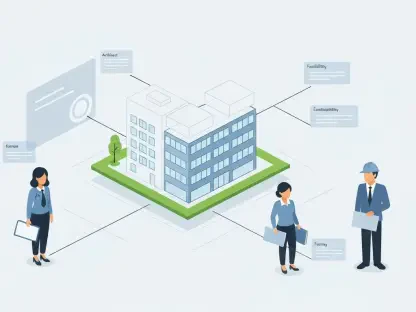Listen to the Article
The construction industry is up against some fresh hurdles in 2025, including new constraints, government programs, and global challenges in 2025. Keep reading to find out six key issues likely to shake things up this year. Further on, you can discover upcoming conferences that target industry leaders who want to solve the below-divulged obstacles.
Six Key Issues in 2025
Challenge 1: Building Safety Overhaul
Safety standards are evolving, as per the UK’s Building Safety Act 2022. This means firms need to adjust to new requirements, which often implies chipping away at their budget.
Key Challenge: As compliance evolves, corporations must keep up. Another change is the expiration of Construction Skills Certification Scheme cards while new training standards are being applied. All in all, those who fail to adapt will face high fines and delays.
Opportunity: In America, firms can stay informed by signing up for the safety regulator newsletter and utilizing resources such as The Building Safety Act’s “Play it Safe” guide to ensure compliance with the latest protocols.
Challenge 2: Launch of Central Digital Platform
Again, in the UK, the Central Digital Platform launched in February 2025. The goal is to modernize public procurement by making it easier for small and medium-sized businesses to participate. This will simplify the registration process and manage data more efficiently while still keeping necessary checks for qualifications.
Key Challenge: The Platform will not verify or evaluate suppliers’ qualifications, so suppliers must also ensure they qualify for government tenders’ prequalification status.
Opportunity: To help prepare for registration, you can gather financial records and company details to make the government contract process easier and faster.
Challenge 3: Workforce Challenges in Construction
The industry is growing fast, with new projects appearing everywhere. However, there aren’t enough skilled workers to keep up with this demand. The Associated Builders and Contractors predict they will need 439,000 more workers in 2025. Governments, however, stand ready to support initiatives that retrain skills and provide apprenticeships to reduce the use of overseas workers and instead rely on a homegrown workforce.
Key Challenge: Labor shortages continue to plague businesses, and they’re looking for ways to attract, train, and keep skilled workers to meet ever-increasing demand.
Opportunity: Apprenticeship grants can also help companies prepare for employment law changes, such as an end to zero-hour contracts and increased rights for flexible working.
Challenge 4: Putting Occupational Health and Safety Front and Centre
According to the Bureau of Labor Statistics Census of Fatal Occupational Injuries, the construction industry recorded 1,075 fatalities in 2023. The report states a rate of 9.6 fatal work injuries per 100,000 full-time workers, steady from last year. With upcoming government building plans, companies must enforce strict safety measures to protect their workforce.
Key Challenge: Organizations must ensure the safety of their core business operations; otherwise, accidents, injuries, and fines can derail business operations.
Opportunity: Improving credibility around keeping employees safe will allow you to reduce risks through regular audits and comprehensive training programs. By adopting recognized safety standards, a company will improve its reputation and attract clients who value worker well-being.
Challenge 5: Mental Health as a Strategic Goal
In 2020, the Center for Disease Control and Prevention found that men in construction have one of the highest suicide rates, and it is about four times higher than that of the general population. Half of all laborers in the UK in a 2024 survey said that they had experienced mental health challenges, and 12% had contemplated self-harm. The fact that employers have a leading role in surface presenting these challenges since they can choose to prioritize mental health and well-being in the workplace.
Key Challenge: Tackling mental health issues requires creating a culture of openness and support, which may be challenging in an industry where these problems are often stigmatized.
Opportunity: Incorporating mental health strategies into company culture can enhance well-being and reduce stigma in the workplace.
Challenge 6: Driving Sustainability in Construction
As of February 2025, the Procurement Act 2023 requires businesses to prove they’re environmentally responsible in order to land government contracts. Reaching net-zero targets is necessary, so the demand for eco-friendly materials, energy-efficient designs, and better waste management might skyrocket.
Key Challenge: Achieving this goal requires significant investment in green technologies, waste management solutions, and energy-efficient designs.
Opportunity: Credentials like Building Research Establishment Environmental Assessment Method and Leadership in Energy and Environmental Design certifications enable companies to comply with statutory requirements, improve their reputation, and compete in a market associated with growing environmental awareness.
Building Resilience to Challenges through Conferences
Businesses encountering complex challenges during 2025 open up multiple prospects for innovation and expansion. Construction companies that want to succeed in evolving markets should maintain knowledge of current regulations along with technological adoption and both physical and psychological support for workers. These major problems require a direct approach from businesses to establish a secure, sustainable, and resilient future.
Conferences and exhibits are valuable occasions for industry pioneers, architects, professional experts, and contractors to construct the organization with leaders in the scene. With regard to 2025, the events are going to be pivotal, including many opportunities to delve into leading subjects such as artificial intelligence, business strategies, safety innovations, and new building techniques.
Read on to explore some of the most awaited conferences for the rest of 2025. Mark their date, location, and focus if you aim to boost your skills, acquire the newest technologies, or meet professionals whom you can learn from.
International Mass Timber Conference
Date: Mar. 25–27
Location: Portland, Oregon
Description: The International Mass Timber Conference is a big event focusing on the use of lightweight cross-laminated timber. This event aims to discuss the future of lumber as a sustainable material. Attendees will get a better understanding of how timber is being integrated into large-scale projects in Portland by attending facility tours and building demonstrations.
Association of the Wall and Ceiling Industry Convention + Expo
Date: Mar. 31–Apr. 3
Location: Charlotte, North Carolina
Description: The Association of the Wall and Ceiling Industry Convention and Expo is an annual event focused on what is used in building walls and ceilings. This event provides considerable information on recent innovations and practices of leading wall and ceiling contractors through a busy schedule of panel discussions, networking receptions, and an exhaustive exhibition hall. Attendees will have the chance to engage with the sector’s biggest suppliers, manufacturers, and other professionals to explore wall and ceiling design trends, as well as acoustics and installation techniques.
World of Modular
Date: Apr. 7–10
Location: Las Vegas
Description: The World of Modular Conference is the largest event in the modular building industry. It brings together builders, architects, and suppliers from across the globe to discuss current trends, technologies, and strategies in this sector. The conference will provide educational sessions and present innovative modular solutions for residential, commercial, and industrial projects.
The Associated General Contractors of America Convention
Date: Apr. 8–10
Location: Columbus, Ohio
Description: The Associated General Contractors of America Annual Convention is a must-attend event for builders and includes educational panels on project management, labor, and other topics, including emerging infrastructure sector technologies. With plenty of time allotted for networking with peers during breaks and breakout sessions, attendees will also hear from thought leaders about trends, legislative updates, and best practices in construction management. It is a huge event, enabling contractors to stay ahead of industry changes.
Advancing Preconstruction Conference
Date: May 21–23
Location: San Diego
Description: The audience of this conference is people working in the pre-building phase of a project, specifically in the areas of cost estimation, scheduling, and integrating building information modeling and mechanical, electrical, and plumbing trades. The sessions will look at ways to make better decisions during the design phase. The goal is to show investors how to save money and lower risk.
Engineering News-Record FutureTech
Date: May 6–7
Location: San Francisco
Description: Engineering News-Record FutureTech is intended for business and IT leaders who use emerging technologies to reshape the development field. This event is a who’s who in the latest construction tech, from AI and robotics to augmented reality and big data. Attendees will learn how advances in automation can help reduce project costs, improve collaboration, and increase project efficiency.
Construction Employers of America National Issues Conference
Date: May 6–8
Location: Washington, D.C.
Description: The Construction Employers of America’s annual conference brings together contractors, legislative experts, and government representatives to discuss critical issues affecting partnerships in the sector. Take advantage of the expert presenters who will share knowledge of labor laws, regulatory changes, and public policy to help you navigate the political landscape, including the future of industry unions in America.
Conclusion
With March 2025 already here, the construction industry is tackling some major challenges, from evolving safety regulations to workforce shortages and the drive for greater sustainability. To stay competitive, companies need to stay informed, prioritize worker well-being, and adopt new technologies and eco-friendly practices to succeed in this fast-evolving landscape.
That is why trade shows maintain their important role in information dissemination, so enterprises need to stay updated and connected at all times. Conferences are vital opportunities for acquiring knowledge about trends, networking with peers, and enhancing strategic business plans. Check event websites regularly and mark these must-attend 2025 dates in your calendar.









